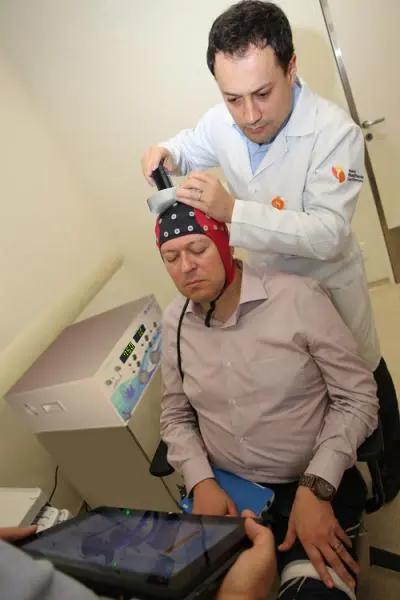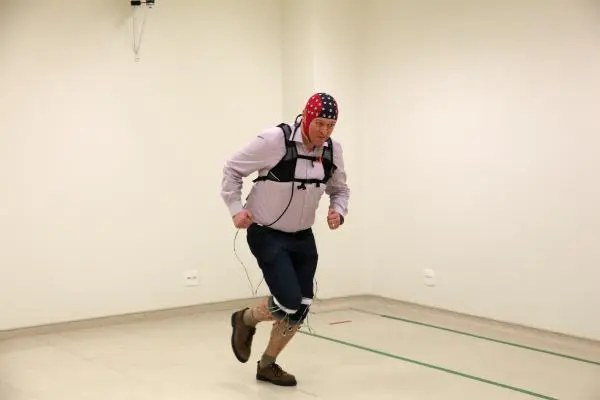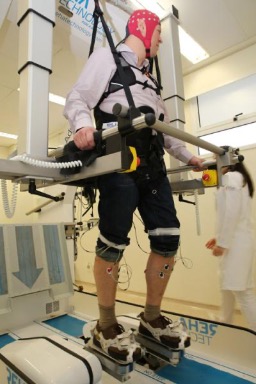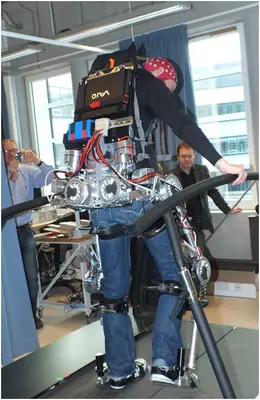The eego sports system records brain (EEG) and muscle (EMG) activity together, enabling researchers and clinicians to map how neural signals translate into movement—crucial for conditions like stroke, Parkinson’s, CP, spinal cord injury, and MS. It integrates with TMS (to probe cortical excitability while reading EEG/EMG responses), gait labs (force plates, motion tracking), and rehab robots, synchronized via TTL/BNC/DB-25 triggers. This mobile setup supports precise timing, real-world movement studies, and brain–computer interface applications such as the Mindwalker exoskeleton, ultimately guiding therapies that restore or compensate motor function.
EEG and EMG in rehabilitation
In this application case we elaborate on the application of the eego sports system in rehabilitation settings. The eego sports systems measures EEG and EMG in one device and can be used in conjunction with other devices such as Transcranial Magnetic Stimulation (TMS), Walking Labs with Force Plates and Rehabilitation Robots.
Rehabilitation
One can describe Neurorehabilitation to be a complex medical process that aims at recovery from a nervous system injury and to minimize and/or compensate for related functional alterations or disabilities. There may be several underlying conditions that could be treated by neurorehabilitation, for example:
- Stroke recovery
- Cerebral palsy
- Parkinson's disease
- Brain injury
- Spinal cord injuries (paraplegia / quadriplegia)
- Multiple sclerosis
- Post-polio syndrome
- Guillain-Barré syndrome
These conditions have in common that there is impaired communication between the initiator (or source) of movement (brain, specific motor cortex) and the actuator of movement (muscles). The Central Nervous System (brain and neural pathway) can be considered a highly complex and extremely versatile and dynamic neural network with countless inputs and outputs. Should one want to achieve any functional improvement in neurorehabilitation, one should at least be able to repair or substitute that part of the neural network that is not functional anymore. Goals may be to permanently replace, or repair, the impaired functionality. In either case one needs to study the relations between inputs and outputs of the system in order to achieve the goals.
A lot of research is put into regaining the lost functionality. Treatment typically includes medication and several types of therapy, ranging from speech therapy to exercise therapy. New technologies exist that can help with these therapies and even incubate new therapies. (O’Dell et al. 2009)
With a combined EEG (brain activity) and EMG (muscle activity) measurement system, researchers are able to develop new technologies and therapies and assess the resulting changes in the patient’s brain and muscles.

Combined EEG and EMG
Combining two physiological signals EEG and EMG is one of the strong points for rehabilitation research. Where the first measures what is going on in the brain, the second measures what is going on in the muscles. Differences in activity in the EEG and in the EMG as compared to the normal pattern in healthy subject can point to the cause of the loss of motor functions.

EEG, TMS and EMG Response
Transcranial Magnetic Stimulation (TMS) is a technique that delivers a high energy magnetic pulse to the head of the patient which induces an electrical current in the brain tissue. When stimulating at for example the motor cortex the activation of the corresponding muscles can be monitored by measuring its EMG response. In order to investigate the effect of the TMS pulse in the brain, EEG can be measured simultaneously. (Rossi et al. 2004) The eego sports system provides a platform to combine such measurements in mobile settings without being bound to cables, power outlets or desktop computers to store the information.

Walking, posture and Gait Research
The eego sports system can also be used in combination with other devices such as force plates or motion trackers to obtain more insight into the patient’s posture and gait. The combination with EEG as measured by the eego sports system can for example show to what extent the patient is still exerting the brain related to normal movement behaviour.

Combination with Other Devices
Devices such as force plates and motion trackers can be synchronized by means of the 8-bit TTL trigger input that is available on the eego sports system. The system supports single bit triggers through a BNC (coaxial) connection as well as multibit triggers through a parallel port (DB25). Single bit triggers can be used to simply synchronize two different data files or indicate when a certain action has happened, such as a TMS pulse. Multibit triggers are especially useful when more complex systems are coupled to the eego sports system, such as stimuli presentation systems, or complex rehabilitation robots with different programs aimed at improving muscle control as pictured below.


The Mindwalker Project
The Mindwalker project’s aim was to develop a system that helps people with an impairment of the lower limbs with their daily activities. This system makes use of the measurement of EEG as an input for a Brain-Computer Interface (BCI). The BCI controls the input to an exoskeleton, which supports the weight of an adult person and assists the movement of the lower limbs. The subjects are controlling this feedback-loop with their EEG activity by imagining movement (Mindwalker 2013).

References

“TMS in cognitive plasticity and the potential for rehabilitation” in Trends in Cognitive Sciences, Volume 8, Issue 6, 1 June 2004, Pages 273-279, ISSN 1364-6613
by Simone Rossi, Paolo M. Rossini

“Stroke Rehabilitation: Strategies to Enhance Motor Recovery” in Journal Annual Review of Medicine. Volume 60, Issue 1, 2009, pages 55-68
by Michael W. O'Dell, Chi-Chang David Lin, Victoria Harrison
